Overview
Within This Page
Special libraries include those other than public, academic, and school libraries. Corporate, medical (see also Department of Veterans Affairs, VA Handbook 7610, Chapter 400–VHA–Library Service), law, religious, armed forces, and government libraries are examples of special libraries. Special libraries house specific information. For example, a law library houses law-related documents and materials, and religious libraries house information pertaining to religion. Like school libraries that are used only by faculty and students of a particular school, special libraries are often used only by certain groups of people (such as company employees who are the only users of its corporate library). Although the design program for special libraries should address future expansion, collections in special libraries do not grow as fast as those in public, academic, and school libraries. This section focuses on one specific type of special library—the Presidential Library.
Presidential Libraries are federal buildings that house documents and other materials of U.S. presidents. These facilities are used by the public to research information about individual presidents and their terms of office. According to the Architectural and Design Standards for Presidential Libraries, developed by the National Archives and Records Administration (NARA), Presidential Libraries serve the following purposes:
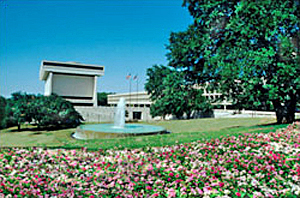
Lyndon Baines Johnson Library and Museum, Austin, TX
- Protect and preserve the archives, audiovisual materials, and artifacts relating to the president, his associates, and his presidential administration;
- Provide access to the historical materials of the president for research and other purposes;
- Provide museum space to communicate the life and times of the president through permanent and temporary exhibits;
- Provide education programs to further the public's knowledge of the former president, the presidency, American history, and the workings of the U.S. government; and
- Provide working space for the archival, curatorial, and educational staffs who process and make available the collections of the library.
Building Attributes
According to the Architectural Design Standards for Presidential Libraries, there are several functional areas that must be included in Presidential Library buildings. The National Archives and Records Administration's (NARA) Office of Presidential Libraries provides programmatic functional requirements for Presidential Libraries.
A. Types of Spaces
A Presidential Library incorporates a number of space types to meet the needs of staff and visitors. These may include:
Public Library Spaces
-
Exhibit Galleries—Both the permanent exhibition and the temporary gallery should be near the lobby. Both galleries should consist of large areas of unencumbered space with a minimum of permanent interior walls. Load-bearing columns should be widely spaced. Total area for both galleries will range from 17,000 to 20,000 square feet. It may be divided between two floors. Ceiling height should be at least 12 feet.
-
Special Events Area—Used for several kinds of activities including social gatherings, receptions, lectures, and special exhibits. The area would be available to the President, and might occasionally provide space for outside professional group functions. It may be used for evening programs when other parts of the building are closed. Restrooms, coat areas, and the catering kitchen should be within the area. It should be accessible from outside so that it can be closed off from the remainder of the building.
-
Orientation Theater—The orientation point before entering the galleries should be equipped with multi-media projection equipment capable of displaying motion pictures, videotape, and computer graphics (at least to XGVA standards), and an audio system suitable for live presentations. Conduit and cabling for computer and telephone communications must be provided to the projection booth and stage. The theater should be located near the lobby and should seat at least 100 visitors.
-
Audiovisual Research Room—This room should be capable of handling three to six persons at one time, and should be located near the audiovisual storage and office areas. Conduit and cabling for computer and telephone communications shall be provided in at least two locations (see also WBDG Productive—Integrate Technological Tools). The audiovisual research room is divided between an open area, where still photographs may be consulted, and an area containing audiovisual research booths with visual access for staff oversight. In the open area there should be one conference table, shelving for reference materials, and file cabinets for the photo index and other reference photographs. A staff workstation with conduit and computer and telephone communications jacks must be located in the audiovisual research room.
-
Research Room—Researchers consult manuscripts, books, periodicals, and oral history transcripts in the textual research room. One archival staff member will be on duty at all times. The room must be constructed without visual barriers that would obstruct surveillance. Conduit and cabling for computer and telephone communications must be provided at staff workstations. Conduit and cabling for computer access should also be provided to each researcher position to provide access to automated holdings and reference tools. Conduit and cabling for at least two common-use computer stations for researchers must be provided (see also WBDG Productive—Integrate Technological Tools). Wiring to support a copier must be provided in the research room. Shelves must be provided for reference materials. The research room should be in a quiet area of the building and have its own point of entry. It should adjoin the orientation area and be bounded on one side by a staff office with glass partition. For efficient service, the stacks should be nearby. Window glazing and light fixtures require UV infiltration. A 100-square-foot room should be provided adjacent to the research room to hold archival materials overnight or in advance of the researcher's arrival. This room must be provided with the same security and environmental conditions as provided for general textural stacks.
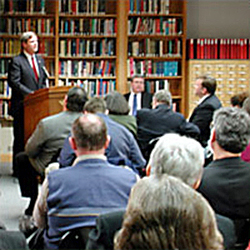
Presentations are held in the Herbert Hoover Library's research room. Herbert Hoover Presidential Library, West Branch, IA
Public Support Spaces
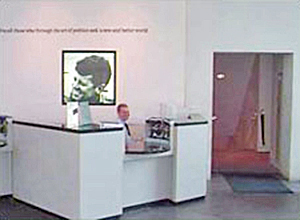
Ticket desk in lobby entrance at John F. Kennedy Library and Museum, Boston, MA
-
Lobby—Serves as the transitional point between all other areas. The overall dimensions should be sufficient to permit up to as many as 3,000 visitors per day to move from the admissions desk to exhibit galleries, the auditorium, restrooms, and sales counter. The museum store, public restrooms, and coat racks should be adjacent to the lobby. The combined capacities of stairways, elevators, or ramps should be sufficient to move 500 people per hour.
-
Museum Gift Shop—Adjoins the main entrance and should be close to the restrooms and the galleries. May serve as an admission collection point and information station. The manager's office should be located just off the store, preferably such that he/she can monitor activity in the store. Provide adequate and flexible display space. Appropriate lighting (track, not recessed) should be used. The gift shop should include ample work space, including adequate space for cash registers and associated computer equipment. There should be abundant electrical outlets. (See also WBDG Joint Use Retail).
Library Support Spaces
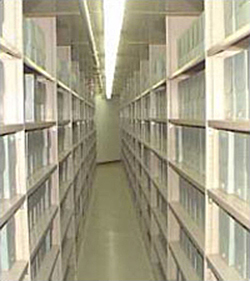
The John F. Kennedy Library's main stack area holds more than 12 million pages of John F. Kennedy's papers. John F. Kennedy Library and Museum, Boston, MA
-
Document Storage Area—Provides long-term storage for textual holdings in the Presidential Library. A portion of the document storage area will be reserved for those documents that require special handling or vault storage. No staff will be stationed in the stacks but all archival staff will make frequent visits. Access will be strictly limited to those staff members requiring access to perform their duties.
The document storage area should have reasonably direct access to the receiving area. It should be close to the research room and archives staff offices. The document storage area should be designed as a restricted area that can be secured from the rest of the building. The floor should be sealed concrete.
The stack rooms will contain rows of heavy-duty shelving. Standard library shelving is not acceptable. The use of "compact" or "mobile" shelving is highly recommended to reduce the quantity to space required. See also WBDG Productive—Design for the Changing Workplace.
An area for storing restricted documents should be located near the security vault. This restricted area will be used to store materials that are not security classified, but require special protection for Privacy Act or other reasons. The restricted area must be separated by a physical, and separately locked, barrier from the rest of the general stack room. This area will contain the same shelving as elsewhere. See also WBDG Secure / Safe—Security for Building Occupants and Assets.
There must be at least two doors from the document storage area to other parts of the archival area. A double door, at least six feet wide, must open directly into a service corridor. A second door, at least three feet wide, should be located to conveniently serve the research room and staff offices. If the document storage area is multi-level, internal staircases and elevators shall be placed along the main aisles and close to the doors. If internal staircases are provided within textual stack areas, special attention must be paid to fire safety and security considerations. See also WBDG Warehouse. -
Orientation / Locker Area—Serves as a conference place for archivists and incoming first-time researchers. Conduit and cabling for computer and telephone communications must be provided for the staff workstation (see also WBDG Productive—Integrate Technological Tools. The researcher orientation area should adjoin the research room and be easily accessible from the lobby reception areas. The room should contain approximately 20 storage lockers and a coat closet. It is recommended that the common partition between the orientation area and the research room be of glass and the door's upper partition be glass also.
-
Processing Room—A common work area (at least 300 square feet) is needed for handling archival collections during the first stages of processing—examining, sorting, arranging, folding, and boxing. It is expected that several processing projects may be underway simultaneously. The processing room should contain large tables for sorting and steel shelving for temporary storage. The processing room should adjoin the document storage room. The processing room must have at least four computer and telephone communications outlets.
-
Museum Processing/Conservation Room—It is in this room that most of the work on the collections will take place. It is a temporary storage room for objects waiting to be processed and integrated into the main storage room. Adequate security must be maintained. This room should be readily accessible to the registrar's office and the collection storage room. Good lighting for all working surfaces is important. Portable and task lights should be provided, and all lights must consist of low-UV emitting fixtures that are additionally UV-filtered. Exterior windows, if present, must be UV filtered. Storage units required for this area consist of open shelves and at least one lockable cabinet. Conduit and cabling for computer and telephone communications in at least two locations are required. Double doors, each a minimum of 36 inches wide, must be provided to give the best possible access to this space.
-
Audiovisual Laboratory Area—For the preparation and preservation of motion film and audio and videotapes. An audiovisual archivist and perhaps a technician will occupy this area. Two computer and telephone outlets must be provided. The processing area should be adjacent to the audiovisual storage and research room. The audiovisual complex should be accessible via corridors to the receiving room. It should contain a high-speed audio reproduction machine and several audio tape-recording machines. If video tapes are produced "in house" then a quality video taping machine will be needed as well as color television monitors and a color television receiver. Motion film preservation will require one or two motion film viewers, film splicer, light table, and a fume hood for use when solvent-cleaning film. Particular attention should be paid to the air-conditioning system and to the flooring. The latter should be computer grade to permit the running of cables and wires beneath the raised surface and to allow for easy maintenance. The audio processing area should be soundproof. There should be a sink in the room. Electrical service to this area should be on two circuits with four outlets per circuit.
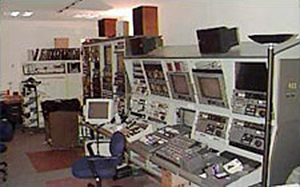
The Audiovisual Archives staff use the editing console to duplicate audiotapes, discs, and films for researchers and to develop original productions of Kennedy Library and Library Foundation events. John F. Kennedy Library and Museum, Boston, MA
Administrative Support Spaces
-
Presidential Suite—It is possible that the President will use a suite of offices in the Presidential Library after he leaves office. The U.S. Secret Service will also need an area of undetermined size within the Presidential Suite to accommodate personnel and equipment needed for the protection of the former President. Secret Service support facilities will not be located within the Presidential Library complex.
-
Director's Suite—This is the administrative center of the Presidential Library. The Director's Suite should be near the main entrance. It should include offices for the Director, Assistant Director, Supervisory Archivist, Curator, Administrative Officer, and Secretary/Receptionist. It should also include a file room. Each office will require conduit cabling for computer and telephone communications at each workstation.
-
Curator's Office—Should be approximately 150 square feet and located near the Director's suite. Entry to this office is through the reception area. It does not have to adjoin the production room, paint shop, freight elevator, or loading dock. Conduit and cabling for computer and telephone communications at each workstation should be included.
-
Exhibit Specialist's Office—Furnishings should include a work table at least 3 feet by 5 feet, a drafting table, office desk, and a number of closed steel cabinets. Planning, layout work, model construction, and graphics preparation for exhibits will take place in this room. Conduit and cabling for computer and telephone communications at each workstation should be included.
-
Museum Registrar's Office—This office should be of sufficient size to house a bookcase, card file drawers for museum accessions, two filing cabinets, work table, and desk. It should contain built-in storage space for museum record-keeping and accessioning program equipment. It should be close to or adjoin the collections storage room. Conduit and cabling for computer and telephone communications at each workstation should be included.
-
Archival Staff Office—Private offices (150 square feet each) should be provided for the Supervisory Archivist, Declassification Archivist, and the Audiovisual Archivist. The remainder of the archival staff may share semi-private or group offices of at least 100 square feet per person. Staff offices should be clustered as close as possible to the document storage area and near the research room. The offices should be accessible to staff restrooms. Built-in shelving should be considered as part of the space arrangement. Exterior windows are desirable and should have UV filtration (see also WBDG Daylighting). The layout should allow sufficient room to store one or two book carts filled with archival material. Each office will need a conduit and cabling for computer and telephone communications at each workstation.
-
Conference Room—Used for staff meetings, seminars, or lectures. The room requires several large tables, a maximum of 50 portable/stackable chairs, and a retractable screen. A conduit and cabling system for computer and telephone communications in at least three locations is needed (see also WBDG Productive—Integrate Technological Tools). A permanently mounted video projector, capable of projecting computer graphics (XGVA or higher) and videotape, with wall-mounted access cables, must be provided. Conference rooms should be located near the lobby area.
-
Lunchroom—Open to all staff but not to researchers. It should be within reasonable proximity to the staff offices but as far away as possible from the storage and processing rooms. Provide a sink, refrigerator, stove, microwave, cabinet space, counter space, and vending machines. The lunchroom should be maintained at a slight negative air pressure to the rest of the building, and should be vented directly to the outside rather than being connected to the general building return air system. One telephone outlet should be provided.
-
Staff and Researcher Restrooms—There should be three units for each sex, one of which must be accessible to people with disabilities. A water fountain outside the restrooms is required.
Storage Spaces
-
Classified Document Storage Vault—A secure vault meeting the requirements of Director of Central Intelligence Directive 1/21 ("DCID 1/21") must be provided. The vault must have solid walls (poured, reinforced concrete or specially reinforced concrete block construction) from true floor to true ceiling. Any wall penetration greater than 90 square inches must be secured by welded bars on 6–inch centers. The vault door shall be a GSA-approved Class 5 vault door. A security entrance vestibule shall be provided. All conduit, pipe, and HVAC ducts must have a non-conductive coupling at the vault walls. The vault shall have a sound attenuation rating of at least 45. A separate, direct conduit must be provided from the vault to the security control room. The vault should have two telephone outlets (separate from the general building telephone system) for a secure voice telephone and secure FAX. The vault requires at least two separate electrical circuits, one with four convenience outlets and the other to serve the secure copier. See also WBDG Secure / Safe—Security for Building Occupants and Assets.
-
Museum Collection Space—All museum objects not on exhibit or in preparation (98 %) will be housed here. While no one will work in this space full time, all museum staff members will spend some time in this room examining items for exhibit preparation and condition assessment. On occasion, a researcher will work here under staff supervision. The room should be accessible to the registrar's office and the processing/conservation room. The storage room must not adjoin the production shop nor can it have windows.
The floor must be sealed concrete, and the ceiling shall be a height of at least 12 feet. One of the major considerations in the storage area should be the utilization of floor-to-ceiling space. Movable ladders should be on hand to allow access to objects stored on the upper levels. See also WBDG Functional—Account for Functional Needs.
The type of storage equipment and furniture should include metal shelving and wardrobe type storage cabinets. Closed cabinets in the storage room should be provided with locks and must be constructed as to be dust and insect proof. There should be some open storage within the room for outsized objects. If there is a sizable art collection, rolling art storage racks are most useful. Rack dimensions would be 10 x 12 feet and constructed of aluminum frames. The frames would be suspended from the ceiling and provide storage for two-dimensional works of art. In addition to fire safety systems, the storage room (as with the rest of the building) must be waterproof and vapor sealed. -
Secure Museum Storage—Provision must be made for the storage of high intrinsic or diplomatic value artifacts in a secure vault, either within the general museum storage area or as a separate room. See also WBDG Secure / Safe—Provide Security of Assets.
-
Audiovisual Storage—Audio and videotape, and other sound recordings will be stored in this area, which is accessible to staff only. Metal shelving shall be installed in this area. Electrically operated compact shelving is permitted. See also WBDG Warehouse.
-
Audiovisual Cold Storage—The audiovisual storage area should include a cold storage vault for the storage of color motion picture film, photographic prints, negatives, and transparencies, black-and-white acetate film (microfilm, stills, and motion picture). The cold vault should include metal shelving identical to that installed in the audiovisual storage area. Because of the heavy stress loads on flooring, the vault should be on the ground floor adjoining and accessible from the audiovisual storage area only. Staff will enter this area occasionally. See also WBDG Warehouse.
-
Sales/Theater Storag—This area will provide storage for sales shop items not stored in the shop and for tables and chairs not in use in the theater/multi-purpose room. One side of the room should be equipped with shelving for storage of sales shop items. If the style of chairs purchased for the multi-purpose room requires racks for storage, sufficient space for 200 chairs should be provided. See also WBDG Warehouse.
Operation and Maintenance Spaces
-
Facility Manager's Office—This office space should be approximately 150 square feet. This office is used to conduct business, as a storage room for facility and contract files, and to hold meetings with library personnel and contractors. It should include one desk, a computer with credenza, a drawing board and container for drawings, a bookcase for manuals and reference books, additional chairs for small meetings, a work table, and adequate file drawers and map cases to contain the many papers and diagrams held by the facility manager. The office should be in the general office area where both library staff and contract employees can easily access it. This office will need conduit and cabling for computer and telephone communications outlets and a direct conduit to the security control room.
-
Museum Production Shop—All exhibit construction takes place in this area. This room should adjoin the exhibit studio, not far from the loading dock and freight elevator. It does not need to be close to the collection storage room or any of the offices. It should have double doors opening from the corridor and paint shop. The production shop must have a positive air pressure relative to the paint shop. The doorways should be as wide as the corridor and as high as the ceiling. This shop should be equipped with a double-sink and counter. Furnishings should include a complement of power and manual woodworking tools including a bench saw, handsaw, radial arm saw, drill press, lathe, and belt sander. There should be several work benches with vises and provisions for stacking lumber and plastics as well as a number of metal cabinets with adjustable shelves. All necessary safety equipment should be provided (see also WBDG Secure / Safe—Occupant Safety and Health). See also WBDG Warehouse.
-
Paint Shop—Spray, roller, and brush painting and Formica lamination of exhibit pedestals takes place in this room. It should adjoin the museum production shop and the corridor and have double fire-rated doors leading to each (each leaf of these doors should be not less than 26 inches wide and not more than 42. The paint shop will require special hazardous environment electrical fixtures and lighting, and must be separated from adjacent occupancies by a 4–hour rated firewall. Furnishings include a paint booth with hood vented to an exhaust air system separate from the house system (see also WBDG High Performance HVAC), several benches at least 8 feet long, and several closed cabinets for storage of paints, solvents, and adhesives. Storage cabinets must be Underwriters Laboratories graded for paint storage and should be vented to the outside. Power equipment will include a compressor for the spray gun, an exhaust fan, and a high-pressure water hose.
-
Exhibit Studio—Final production of exhibits and exhibit mock-ups takes place here. It should not be directly accessible from the production shop and be of a size to permit actual set-ups. It must maintain a positive air pressure relative to the general building. Equipment should include a desk, 6 x 8-foot table, paper cutter, dry mount press, light table, silk screen area, workbench, and a large tack board. Storage is required for card stock and art supplies. The exhibit studio should be provided with an exhaust air system separate from the house system (see also WBDG High Performance HVAC).
-
Security Control Center—The security control center shall be located so that two-way radio communications using normal-power hand-held radios can be received from all parts of the building. The security control center should have at least two computer and telephone outlets on the general building system.
-
Computer Room—The computer room should have computer-grade raised flooring to allow flexible cabling within the room. An Uninterruptible Power Supply, capable of maintaining electrical service to a small main-frame style computer, PC-network file server, router, and other critical equipment, shall be provided. This room will be connected to all workstations in the library by a computer communications system consisting of a Main Distribution Frame, Intermediate Distribution Frames, concentrators, repeaters, inter-connecting cabling (or fiber), and IDF-to-workstation cabling. In addition to the UPS-served circuits, the computer room must be served by at least 10 dedicated 20–amp computer-grade circuits, each with four convenience outlets. All power outlets in the computer room shall be on the sub-floor (under the raised floor) with flexible tails. See also WBDG ADP (Mainframe) and ADP (PC) and WBDG Productive—Integrate Technological Tools.
-
Receiving Room—Serves as a staging area where incoming archival material will be unpacked and processed at the basic level. Should adjoin the loading dock and be as near as possible to the processing area. There should be no sharp turns of barriers between the receiving room and the processing area. The room should have a doorway, at least 7 feet wide, to the loading dock. Large metal trash containers and several oversize worktables are needed. Sealed concrete is the best flooring. Fire sprinkler and smoke detection systems should be similar to those recommended for the document storage area. See also WBDG Warehouse.
-
Loading Dock—Should consist of a shipping/receiving alcove or foyer and an archival receiving-processing space. It should be in the same wing as the storage areas. Access to the loading dock from the road must be of sufficient size to handle an over-the-road trailer. It should be vented directly to the outside. See also WBDG Warehouse.
-
Contractor Space—Contractors for mechanical maintenance, custodial, and guard services often require space in the facility. Each of these contractors should have a small office area equipped with a desk, credenza, file cabinet, and two to three chairs. Each office will need conduit and cabling for computer and telephone communications at each workstation. The mechanical maintenance and custodial crews will need additional storage areas for the equipment and materials used on site. There should be two general areas (one for men and one for women) equipped with lockers and showers for all contract employees. Contractor offices should be close to the loading dock. See also WBDG Office.
B. Important Design Considerations
Typical features of Presidential Libraries include the list of applicable design objectives elements as outlined below. For a complete list and definitions of the design objectives within the context of whole building design, click on the titles below.
Accessible
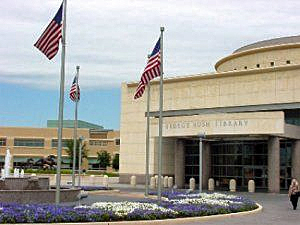
George Bush Presidential Library and Museum, College Station, TX
- Conform to the barrier-free standards set forth in the Americans with Disabilities Act Architectural Guidelines (ADAAG).
Aesthetics
-
The character of the building's exterior and interior should reflect the dignity, enterprise, vigor, and stability of the Executive Branch as well as the personality of the President being honored.
-
Select a limited palette of finishes that responds to construction cost limitations, optimizes life-cycle performance, and satisfies functional requirements should be selected for each project.
Operational
-
Flexibility—Possess flexible, multi-zoned mechanical equipment with state-of-the-art controls and energy efficient features. Electrical design should anticipate future requirements for video and audio systems; electric data processing, retrieval, and display; electronic security systems; and new generations of sophisticated office equipment.
-
Acoustic Control—To control noise during all modes of operation, the systems must be provided with one or more of the following: sound traps and acoustical lining in duct work, low-velocity, low-static-pressure fan systems, and/or special low-noise diffusers.
-
Corridors and Elevators—Service corridors should be level and at least 8 feet wide. The corridor leading form the loading dock to the museum floor should have a 12–foot-high ceiling. Service corridor floors should be sealed concrete. Carpeting is appropriate for office-area corridors. Corridor walls may be of the same material as the galleries. Windows installed in corridors must be wired to the alarm system. If the building is multi-story, at least one freight elevator should serve the museum area and be reasonably close to the production room and collection storage room. Two additional elevators will be required, one in the public areas and one in the document storage areas. The museum freight elevator should have a minimum dimension of 10 feet x 10 feet and door dimensions of 10 feet wide by 12 feet high. It should have a lifting capacity of at least 4,000 pounds. Other elevators will carry people and small carts of documents, with a capacity of 2,000 pounds. The most economical elevator system for a two-story facility would be a hydraulic unit. A traction elevator is not suited for two-story installation.
Secure / Safe
-
Plan with security for occupants and assets as an integral and crucial design consideration.
-
Presidential Library security is complex in that library components and circulation patterns require a varying degree of security. Three separate zones of circulation should be defined—public, restricted access, and secure.
-
An Uninterruptible Power Supply capable of powering all fire alarm consoles, security alarm consoles, and access control systems must be provided. The security control center lighting, and CCTV monitors must also be on the emergency generator circuit. The security control center must be capable of monitoring all fire and security trouble and alarm conditions and must also be capable of monitoring all critical HVAC systems. Monitoring of access control systems and CCTV shall also be provided. See also WBDG Secure / Safe—Security for Building Occupants and Assets.
Emerging Issues
See Academic Library: Emerging Issues, Public Library: Emerging Issues, and School Library: Emerging Issues.
Relevant Codes and Standards
- 44 U.S.C. § 2107—Presidential Recordings and Materials Preservation Act of 1974 (applicable only to the presidential historic materials of Richard M. Nixon)
- 44 U.S.C. § 2108—Presidential Libraries Act of 1955
- 44 U.S.C. § 2112; P.L. 99-323—Presidential Libraries Act of 1986
- 44 U.S.C. § 2201–2207—Presidential Records Act of 1978
- BOCA National Building Code, Building Officials and Codes Administrators.
Note: Contact the National Archives and Records Administration (NARA), Washington, DC, for applicability of the International Code Council's ICC IBC International Building Code. - For egress requirements, the provisions of the National Fire Protection Association (NFPA) 101, Life Safety Code, can be followed in lieu of the egress requirements of BOCA's National Building Code.
Additional Resources
Associations and Organizations
Publications
- Architectural and Design Standards for Presidential Libraries by National Archives and Records Administration, Office of Presidential Libraries. 2014.
- Directory of Special Libraries and Information Centers. Published by Gale Research.








